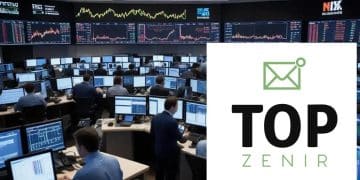Vanguard cuts 2025 US economic growth projection

Vanguard has cut its 2025 US economic growth projection, prompting concerns over inflation, interest rates, and their subsequent impact on consumer spending and overall economic stability.
Vanguard cuts 2025 US economic growth projection raises eyebrows among economists and investors alike. What factors led to this change, and how will it impact the broader market? Let’s delve into the details.
Overview of Vanguard’s economic outlook
Vanguard’s economic outlook provides valuable insights for investors and policymakers alike. Understanding their projections can help us navigate future economic landscapes more effectively.
Current Economic Situation
In its latest report, Vanguard highlights several key indicators that shape its economic forecasts. The overall sentiment is cautious, reflecting potential challenges ahead. Slowing growth and rising uncertainty are major themes in their analysis.
Key Factors Influencing Projections
- Global economic trends: International markets and geopolitical issues play a significant role.
- Consumer behavior: How consumers respond to economic changes can impact growth.
- Government policies: Stimulus and regulation will also shape future prospects.
These factors combined create a complex picture. Investors must stay informed to make smart decisions. Furthermore, the trajectories of inflation and interest rates will be crucial in shaping this outlook. Understanding how Vanguard anticipates these changes enables better preparation for potential market movements.
Long-term Predictions
Vanguard’s long-term predictions suggest a more muted recovery compared to previous years. This is due to various pressures, including labor shortages and the impacts of technological advancements on employment. As Vanguard notes, adapting to these changes is essential for both the economy and individual investors.
In summary, keeping an eye on Vanguard’s assessments is vital. By understanding the projected economic landscape, stakeholders can navigate their strategies much more adeptly. With changes on the horizon, preparation and awareness are key to thriving in this ever-evolving economic environment.
Implications of reduced growth projections

The implications of reduced growth projections from Vanguard are significant and wide-ranging. As the forecast indicates a slowdown in the economy, both businesses and consumers should prepare for potential challenges.
Impact on Investment Strategies
Investors may reassess their strategies in response to these lowered projections. A cautious approach could lead to a shift towards safer investments, such as bonds or dividend-paying stocks. In volatile markets, preserving capital often becomes a priority. Understanding Vanguard’s insights can guide investors as they navigate these changing dynamics.
Consumer Spending Trends
With economic uncertainty, consumer confidence may decline. As people feel less secure about their financial situation, spending may decrease accordingly. This drop in consumer spending could further affect economic growth, creating a cycle of slower recovery.
- Shifts in discretionary spending patterns.
- Increased savings rates as consumers become cautious.
- Businesses may adjust pricing strategies.
Additionally, companies might feel the pressure to adapt to changing consumer behaviors. Understanding these implications can help businesses align their strategies with market realities. They may need to innovate or diversify their offerings to capture wary consumers.
Long-term Economic Effects
The long-term consequences of reduced growth projections can reshape the economic landscape. Potential issues include higher unemployment rates and a slowdown in wage growth. These factors can result in lasting impacts on the workforce and overall economic health.
Organizations and policymakers must work together to address these challenges. By fostering a robust policy environment, they can help mitigate potential risks associated with reduced growth rates. Monitoring trends and adjusting approaches will be crucial for long-term resilience.
Factors influencing economic growth
The factors influencing economic growth are complex and interconnected. Understanding these elements can provide insight into what drives the economy forward.
Consumer Spending
One of the most significant factors is consumer spending. When people feel confident, they tend to spend more money on goods and services. This spending stimulates businesses, leading to production increases and job creation.
Investment Levels
Investment from both businesses and government is crucial for economic growth. When companies invest in new technologies or facilities, it can lead to greater efficiency and productivity. Meanwhile, government investment in infrastructure can create jobs and boost economic activity.
- Increased investment leads to innovation and competition.
- Government spending can stimulate areas hit hardest by recession.
- Higher investments in education can improve workforce skills.
Additionally, the level of exports contributes to economic health. When a country sells goods and services to other nations, it creates a balance that positively affects its economy. Strong export markets can provide businesses with more opportunities to grow.
Economic Policies
Government policies, such as taxation and regulation, also play a critical role in shaping economic growth. Lower tax rates can encourage businesses to reinvest profits, while stable regulatory environments can foster innovation and entrepreneurship. These policies directly impact business confidence, which is essential for long-term growth.
Furthermore, global economic conditions affect local economies. A downturn in major trading partners can lead to reduced demand for exports, impacting growth rates. Understanding how these various factors interact helps in navigating economic changes.
The role of consumer spending
The role of consumer spending is vital in driving economic growth. It influences the overall health of the economy by affecting production, job creation, and investment levels.
Impact on Economic Growth
When consumers are confident, they spend more on products and services. This increased spending leads to higher demand, which in turn encourages businesses to produce more. As production ramps up, companies may need to hire additional workers, further boosting the economy.
Trends in Consumer Behavior
Consumer behavior can change due to various factors, including economic conditions, consumer confidence, and even social trends. When the economy is strong, people feel more secure and are likely to make larger purchases, such as homes or cars.
- Higher disposable income usually leads to increased spending.
- Inflation can erode purchasing power, influencing spending habits.
- Seasonal trends often affect specific purchases, such as clothing or electronics.
Additionally, events like holidays or major sales can significantly impact spending patterns. Understanding these trends is important for businesses looking to align their strategies with consumer expectations.
Effects of Economic Downturns
During economic downturns, consumer spending typically declines. People may hold back on spending due to uncertainty about their financial future. This can create a downward cycle, where decreased spending leads to lower production and higher unemployment. Businesses must prepare for these fluctuations by adjusting their operations and offerings to meet changing demands.
By monitoring consumer spending trends, businesses can better anticipate shifts in the market and adapt their strategies accordingly. Overall, consumer spending is a crucial factor that shapes the economy and influences growth trajectories.
Predictions for inflation and interest rates
Predictions for inflation and interest rates play a crucial role in shaping economic policies and consumer behavior. Understanding these predictions helps individuals and businesses prepare for financial changes.
Current Inflation Trends
Inflation refers to the rate at which prices for goods and services rise. Recently, many economies have witnessed elevated inflation levels, influenced by factors such as supply chain disruptions and rising demand. When inflation is high, consumers may feel the squeeze on their purchasing power, leading to changes in spending habits.
Impact on Interest Rates
Central banks monitor inflation closely, as it often drives decisions regarding interest rates. When inflation rises, central banks may increase interest rates to cool off the economy. This action can lead to higher borrowing costs for consumers and businesses, affecting everything from mortgages to personal loans.
- Higher interest rates can discourage borrowing.
- Consumers may delay big purchases, impacting economic growth.
- Business investments can slow down due to increased costs.
Conversely, if inflation is low, central banks might lower interest rates to encourage spending and investment. These decisions create a delicate balance that impacts all sectors of the economy.
Future Forecasts
Economic experts suggest that understanding future inflation trends is essential for navigating potential financial outcomes. Predictions may vary based on external factors, such as geopolitical events or natural disasters. Analysts often use historical data to project future changes in inflation and interest rates, offering insights into potential adjustments in fiscal policy.
In this ever-changing economic landscape, being aware of inflation and interest rate predictions can help individuals and businesses make informed financial choices. Monitoring these factors is key to understanding how they influence overall economic growth and stability.
FAQ – Frequently Asked Questions about Economic Growth and Projections
What are the key factors influencing economic growth?
Key factors include consumer spending, investment levels, inflation, and government policies, all of which affect economic stability and growth.
How does inflation impact consumer purchasing power?
Inflation decreases purchasing power, meaning consumers can buy less with the same amount of money, leading to changes in spending behaviors.
Why are interest rates important for the economy?
Interest rates impact borrowing costs for consumers and businesses. Lower rates encourage spending and investment, while higher rates can slow down economic growth.
What can businesses do to prepare for economic changes?
Businesses should monitor economic indicators like inflation and interest rates, adjust pricing strategies, and be flexible in meeting shifting consumer demands.





